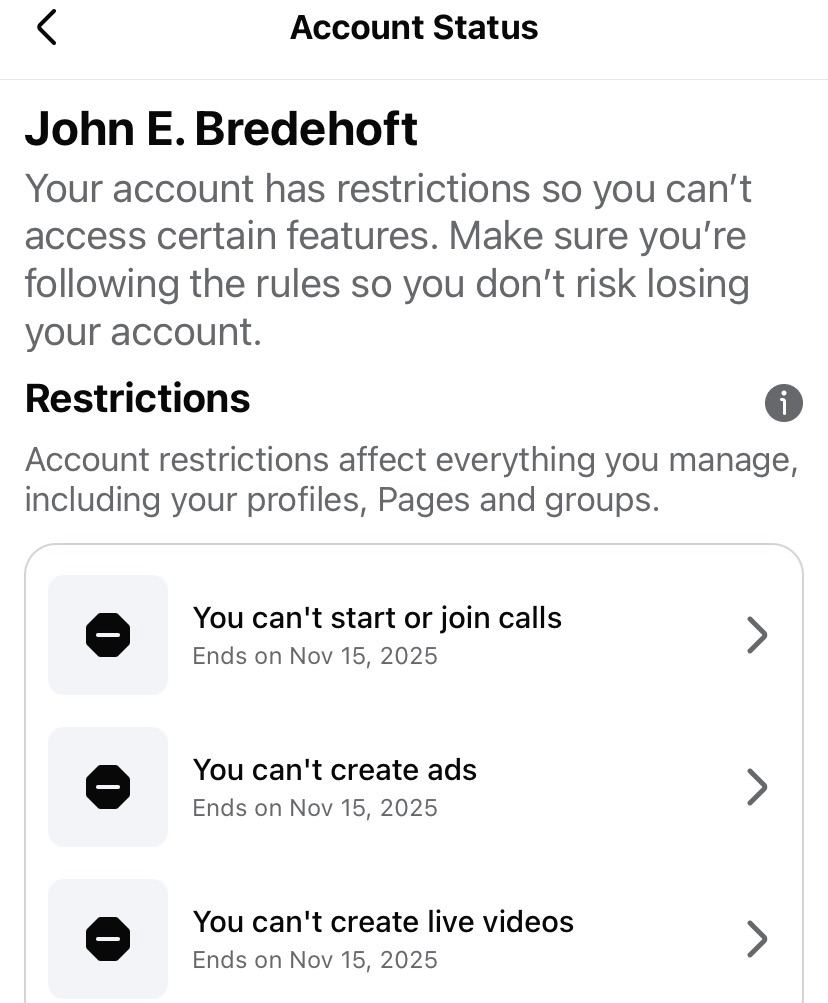So I wrote my Bredemarket blog post about the scam Substack post I saw last night.

Then I shared it to my socials, including Facebook.
But Facebook removed the shares.

And put me on a one month restriction.

I’m appealing.
Identity/biometrics/technology marketing and writing services

So I wrote my Bredemarket blog post about the scam Substack post I saw last night.

Then I shared it to my socials, including Facebook.
But Facebook removed the shares.

And put me on a one month restriction.

I’m appealing.
Inspired by the Constant Contact session I attended at the Small Business Expo, I wanted to conceptualize the Bredemarket online presence, and decided to adopt a “planet with rings” model.
Think of Bredemarket as a planet. Like Saturn, Uranus, Neptune, and Jupiter, the planet Bredemarket is surrounded by rings.

The closest ring to the planet is the Bredemarket mailing list (MailChimp).
The next closest ring is the Bredemarket website (WordPress).
Moving outward, we find the following rings:
While this conceptualization is really only useful to me, I thought a few of you may be interested in some of the “inner rings.”
And if you’re wondering why your favorite way cool platform is banished to the outer edges…well, that’s because it doesn’t make Bredemarket any money. I’ve got a business to run here, and TikTok doesn’t help me pay the bills…

For background, see https://bredemarket.com/2025/10/01/messing-up-meta-data-via-the-meta-challenge/

I confess that Meta AI’s cluelessness often amuses me. I need to start collecting examples, but it is often off the, um, mark.
But if you REALLY want to confuse Meta AI, participate in Bredemarket’s “Meta Challenge”:
Meta Challenge: at least once per day in October and November, go to Facebook and/or Instagram and ask Meta AI the most inane questions you can think of.
And feel free to ask these inane questions of Bredemarket’s own two Instagram bots.
Because we all want to know who is the best Osmond brother.
And Mark Zuckerberg’s shoe size.

Now since Bredemarket’s readers are of above average intelligence (and also have extremely magnetic personalities), you are probably asking why I am promoting this activity.
Simple reason: the data we feed to Meta AI in October and November will be used in December, according to PYMNTS.
Meta will begin using people’s conversations with its artificial intelligence to create personalized ads and content.
The change is set to go into effect Dec. 16, the tech giant announced Wednesday (Oct. 1),
If you are concerned about the Really Big Bunch knowing too much about you, feed them false information just to confuse them.
And maybe you’ll get some wild entertaining ads in return.
And if they complain that you’re intentionally messing up their algorithms, tell the Really Big Bunch that you’d be more than happy to provide the REAL data.
For a price.

In a private Facebook share, Rahsheen Porter quoted from Cal Newport:
“We know these platforms are bad for us, so why are they still so widely used? They tell a compelling story: that all of your frantic tapping and swiping makes you a key part of a political revolution, or a fearless investigator, or a righteous protestor – that when you’re online, you’re someone important, doing important things during an important time.
“But this, for the most part, is an illusion. In reality, you’re toiling anonymously in an attention factory, while billionaire overseers mock your efforts and celebrate their growing net worths.”
The algorithms only show you what they think will cause you to maximally engage. Even in the days of FriendFeed, I never saw content from the extremely active Turkish and Italian communities. Why should I? I saw what FriendFeed wanted me to see.
But I’m thankful that Facebook shows me Rahsheen’s content.
And I am also thankful for those who understood the “Go See Cal” post title.
And finally, I am thankful to the residents and former residents of south Arlington, Virginia who detected the inside joke in the picture above. (Hint: the hoodie was originally gray.)

Just trying to figure out what I would do if Meta lowered the handle on Bredemarket and I couldn’t post audio-enhanced conte n via its platforms.
Thankfully it’s not auto playing. I don’t want to go back to the 1990s again.
And this also covers me if my Spotify-hosted podcasting empire is reduced to rubble.

(Imagen 4)
This was never supposed to go on the Bredemarket blog, but here it is. Because when a product marketing consultant wants to improve his storytelling skills, he practices with…toilet paper.
I’ve been working on improving my AI art generation skills, and even created a special Facebook group, Bredemarket Picture Clubhouse, as my practice area. One of my inspirations has been Danie Wylie, whom I first encountered during the HiveLLM thingie.
Wylie likes to share art challenges, and she recently shared this one. The text below, including the emojis, is straight from the challenge.
📣 New Weekly Wednesday Challenge 📣
🌟 Glitch N’ Sass and AI Anonymous Present:
🎭✨ MESMERIZE THE MUNDANE ✨🎭
Where glitter drips from code and imagination struts in stilettos. @everyone 💥
Take the forgotten, the overlooked, the tragically basic —
and unleash the glam-core magic of AI.
Allow creativity to glitch the system, let sass polish the mundane, all while reshaping reality.
⸻
Flip the script on the everyday:
🥄 A spoon stirs time’s secrets
👟 A shoelace coils into cosmic scales
📎 A paperclip snaps open hidden realms
✨ Rewire purpose.
✨ Reframe presence.
✨ Reveal what the world forgets to see.
📌 Tag it: #AIAnonymous #GlitchNSass #MesmerizeTheMundane
⸻
💬 This isn’t an art drop — it’s an everyday clutch, transformed into a chasm of creativity .
A call to those who see depth in the digital, beauty in glitches, and freedom behind the mask.
We are not escaping the world — we are a reminder, to view it. For all the purposes they told us it never possessed. 🔥
✨ So go on… Mesmerize us, With glitter in one hand and encrypted vision in the other. ✨
Now on the surface such an exercise has nothing to do with “know your business” or “biometric product marketing expert” or “content – proposal – analysis”…
…but it does.
In essence, written business communications are opportunities for storytelling. As I noted, case studies are inspiring stories about how a challenged company realized amazing success, all thanks to the wonderful Green Widget Gizmo.
Now that’s a riveting story.

And of course I’ve performed AI image storytelling before: for example, with my three “Biometric product marketing expert” reels. Here’s the second:
But back to the “Mesmerize the Mundane” challenge. So to participate in the challenge I had to find something mundane. Now some of you think a single finger sensor is mundane…but I don’t. (There’s actually a connection between fingerprint sensors and art, but I’m under NDA.)
So I picked a mundane topic: toilet paper.
What’s even better is that toilet paper is filled with emotion. Particularly relative to the ongoing debate about whether…
I’m not going to say it. I hope this reel—my entry into the “Mesmerize the Mundane” challenge—speaks for itself.
When I shared this reel on Facebook and elsewhere, I did so with the following text.
A storytelling exercise…and a challenge.
You can’t get more mundane than toilet paper, or spawn fiercer battles over orientation. But love conquers battles.
#AIAnonymous #GlitchNSass #MesmerizeTheMundane #BredemarketPictureClubhouse
But before I close this post I will get a little technical.

One of the challenges in multi-image storytelling is the need for consistency between the images. You can’t have the hero wildebeest wearing a blue cap in the first picture and a red one in the second.
So to enforce consistency, I’ve been bundling all my picture prompts into a single request to Google Gemini, and including instructions to enforce similarity between the pictures in the series.

So here is the specific request used to create the four pictures in the reel above.
Draw realistic pictures based upon the following four prompts:
Prompt 1: Draw a realistic picture of a toilet paper holder on a blue tiled bathroom wall, next to the toilet. The toilet paper is white. The toilet paper end is hanging in front of the roll.
Prompt 2: Draw a realistic picture similar to the image in the previous prompt, a toilet paper holder on a blue tiled bathroom wall, next to the toilet. The toilet paper is still white. This time, however, the toilet paper end is hanging behind the roll.
Prompt 3: Draw a realistic picture similar to the image in the previous prompts, a toilet paper holder on a blue tiled bathroom wall, next to the toilet. Now the toilet paper is glowing in a neon red. Due to mesmerizing magic, there is a toilet paper end hanging in front of the roll, and there is also a duplicate toilet paper end hanging behind the roll. The presence of both toilet paper ends removes the conflict of whether to hang toilet paper in front of our behind the roll; now, both are simultaneously true.
Prompt 4: Draw a realistic picture similar to the image in the previous prompts, a toilet paper holder next to the toilet. But now the tiles on the bathroom wall are colored gold, vibrating, and throbbing. The toilet itself is glowing with a bright light. Now the toilet paper is glowing in red, green, and blue, and sparkles are shooting away from the toilet paper roll like fireworks. Again, due to mesmerizing magic, there is a toilet paper end hanging in front of the roll, and there is also a duplicate toilet paper end hanging behind the roll. The bathroom floor is covered in hundred dollar bills and shiny gold coins.
And here are the full square pictures, which do not completely display in the reel.




Now I just have to tell the riveting story of a single finger sensor.

The Meta properties are great for driving engagement, but Meta’s odd and untimely application of its rules can be maddening.
I was checking my personal Facebook account this afternoon when I noticed a “Profile has some issues” message and clicked on the “View details” button to see why my profile had a gold restricted minus sign.

When I clicked on the button I found a list of 11 issues encompassing my personal profile, the Bredemarket page, and the Bredemarket groups.
None later than April 17.

I discussed THAT encounter with the Metabot in my Bredemarket post “Defeating the Metabot to Share Whistic’s Survey Results.” As far as I can tell, my grievous violation was this parenthetical statement:
“(And one more key finding. Read the article.)”
I got flagged because Facebook said my content could “trick people to visit…a website.”

But even after removing the parenthetical comment I got flagged again.
Eventually I just posted a link with no text on Facebook, and since that time have studiously avoided posting calls to action on Facebook posts.
But this past issue remains a present issue because my account is restricted…and I’m supposed to do something about it. But without a DeLorean I’m not sure what. I can’t remove the offending posts since Facebook already did so.
It turns out that Wendy Wilkes wrote about this in late July.
“Many users are seeing this today — it’s caused by old posts flagged by Facebook’s system, not recent activity….
You’re not alone — it’s happening to many!
#FacebookIssue #ContentCreator #StayCalm “

So I guess I will just hang tight and see if it auto clears.
And remind myself again that Facebook is not a dependable platform. That’s the message we’re supposed to get from this…right?

Originally posted on my personal Instagram https://www.instagram.com/reel/DM3KMPvvsR4/
My personal Facebook account is technically a “professional” account, and therefore has Meta’s silly weekly contests. I have the content part down, but I’m NOT creating a Meta personal AI bot. (The Bredemarket Instagram account has two.)

According to Meta AI, “Bredemarket’s history dates back to L-1 Identity Solutions.”
Um, no.
Now that’s a hallucination.